Scent and Subversion (15 page)
Read Scent and Subversion Online
Authors: Barbara Herman

Perfumer:
Jean Carles
In one of the many wonderful 1950s ads for Ambush, a woman giving the viewer a cheeky sidelong glance holds a bottle of perfume in which a hapless man is trapped. What’s interesting about this is that Ambush really reads to this modern sniffer as a masculine perfume. It’s a fougère, after all, with pronounced lavender and tonka (coumarin) notes, two of the three notes that characterize that masculine category.
Whatever the arbitrary gender of Ambush, it’s as interesting as all perfumes by Jean Carles, who seemed to love simple formulas with complex outcomes. The herbaceous, citrus top immediately collides with the warm, sweet, practically gourmand base with a touch of powder, anise, and maybe even civet. Flirty, fresh, and comforting.
Top notes:
Lavender, bergamot, lemon, clary sage
Heart notes:
Geranium, rose, carnation
Base notes:
Vanilla, heliotrope, tonka, sandalwood
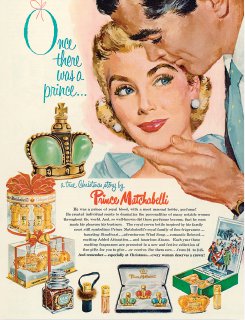
Princess fantasies, anyone? Before it was a brand, we’re told, Prince Matchabelli really was a prince who indulged in perfume-making as a hobby. (Ad from 1957)
by Fabergé (1955)
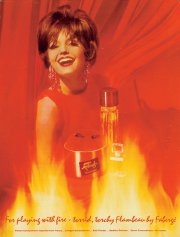
An ad (c. 1966) for Fabergé’s Flambeau
Like a cross between Baghari (1950) and Intimate (1955), but with more spice and fewer inhibitions, Flambeau (“Torch”) is a candied floral chypre/Oriental with facets of burnt sugar and a spicy, creamy-vanilla, gourmand drydown. Delicious.
Notes:
Aldehydes, rose, jasmine, peach, lily of the valley, vetiver, sandalwood, amber, oakmoss, orris
Notes from
Yann Vasnier:
Jasmine, narcissus, rose, vetiver, aldehydic, metallic spicy
by Lubin (1955)
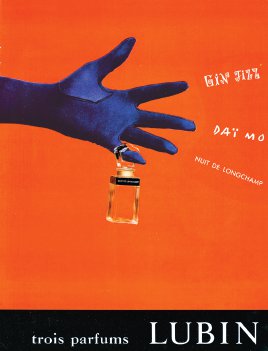
In this 1955 ad for three Lubin perfumes, a gloved cat burglar manages to snag one.
Perfumer:
Henri Giboulet
In the same way that the vintage cocktail cuts the sharpness and sourness of gin and lemon with the softness of egg white, Lubin’s gorgeous Gin Fizz softens lemon and green notes with a base enriched by balsamic notes.
Lemony-rose hits you first, followed by the mellowest drydown of moss, amber, woods, and benzoin. The
1982 Dictionnaire des Parfums et des Lignes Pour Hommes
mentions an herbal aspect. (Thyme? Tarragon? Something that recalls the juniper of gin?) “Gin Fizz is a green, peppery and herbal fragrance … It is a light, fresh and charming eau de toilette for active and sportive youth.” (According to my awesome translator Guy Bertrand, “There is no gender specified in the French. I suppose it is a unisex fragrance, which was quite daring for 1955.”)
Notes from
1982 Dictionnaire des Parfums et des Lignes Pour Hommes:
Lemon, iris, ylang-ylang, rose, vetiver, oakmoss, Mysore sandalwood, Siamese benzoin, amber
by Revlon (1955)
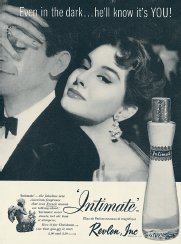
Displaying a bit of an American inferiority complex, this 1956 Intimate ad boasts that “even French women are talking about it!”
This floral/animalic chypre flew out of its 1950s-era bottle like
I Dream of Jeannie
’s genie from her pink satin-lined abode, hips swaying rhythmically to a cha-cha beat.
Crystal-clear aldehydes clear the way for sensual florals, but their impression is made even more overtly sexual by animal notes that give the perfume immediate libidinal heft. Sandalwood, cedar, patchouli, and coriander add a wonderful, intervening spicy/woody counterpoint, and orris transforms all of Intimate’s angles into a creamy, powdery softness.
Intimate is the perfume that promises sex—and delivers. It’s not fooling around. But there’s something good-natured and happy about its opening floral sparkle—something very American, rather than French.
Top notes:
Aldehydes, bergamot, rose, gardenia, coriander
Heart notes:
Jasmine, orris, patchouli, sandalwood, cedarwood
Base notes:
Amber, castoreum, civet, oakmoss, musk
by Lanier (1955)
With a lavender-prominent bergamot and citrus opening, to an ambery-powdery and spicy drydown, La Folie de Minuit (“Midnight’s Folly”) is categorized or “typed” in the
Nips Perfume Guide
as a “forest blend,” meaning that these perfumes are “woody, mossy-leafy or resinous … or they stand out alone with aromatic notes of an individual nature.”
Notes not available
.
by Christian Dior (1956)
Perfumer:
Edmond Roudnitska
Unlike Coty’s Muguet des Bois, the sheer and naturalistic lily-of-the-valley fragrance Roudnitska admired, Diorissimo plunges the innocent lily note into a sensual, narcotic world of creamy jasmine, ylang-ylang, and boronia, the flower from an Australian plant that has a musky, woody-violet scent.
Lily of the valley must be re-created in perfume; extractions from the flower simply don’t hold up. Roudnitska could have tried to give Coty’s Muguet des Bois a run for its money by outdoing the naturalism of that scent. Instead, he decided to dress up the delicate green lily—an ingénue of a flower, really—and take her out for a night on the town. Stunning.
Top notes:
Muguet (lily of the valley), ylang-ylang
Heart notes:
Amaryllis, boronia
Base notes:
Jasmine
by Max Factor (1956)
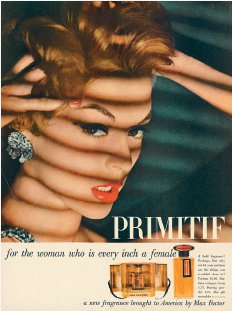
Like the cover of a pulp novel whose heroine is a good girl gone bad, this 1956 ad for Primitif tells you, in case you couldn’t figure it out on your own, that the perfume “said the things you did not dare to.” A classic trope—that perfume was a subliminal language speaking forbidden desires.
With a roar of sharp aldehydes, Primitif announces its not-so-innocent intentions. Within seconds, a rich animalic accord of buttery peach flanked by musky civet saunters in, swiveling its hips down to a spicy, mossy base.
In perfumes like vintage Chanel, Baghari, and Intimate, nitromusks curl, crackle, and fatten up the perfumes they’re in. You have to smell this added dimension to understand what I mean, but the best analogy I can think of is the difference between a dish with butter or without it. Musks provide an olfactory “mouth feel.”
Notes from
Yann Vasnier:
An “oily” accord, powdery accord, aldehydes, green chypre, patchouli, civet
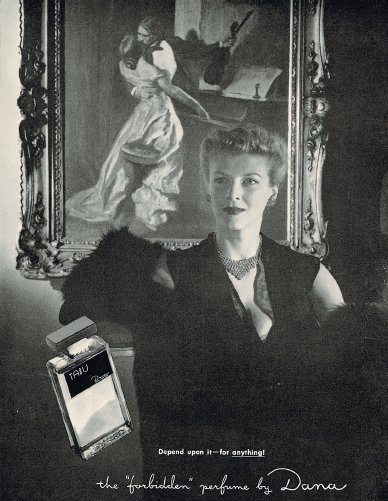
By depicting daydreaming women sitting in front of images of Dana’s iconic kissing couple, these 1950s-era Tabu ads directly addressed perfume’s relationship to fantasy. They didn’t promise women that men would fall over themselves if women wore it; they did something more interesting. They invited women to have a relationship with their own desire, to dream and fantasize about romance and sex. Perhaps the taboo of Tabu is for a woman to have a relationship with her own erotic fantasies, however conventional they may be.
by Givenchy (1957)
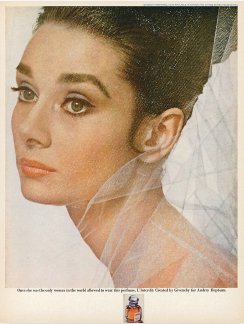
With Audrey Hepburn’s expressive, elegant face dominating this 1960s ad for L’Interdit, the equivalence is made between Hepburn’s and the perfume’s chic sensibility. After all, the perfume was first made exclusively for her.
